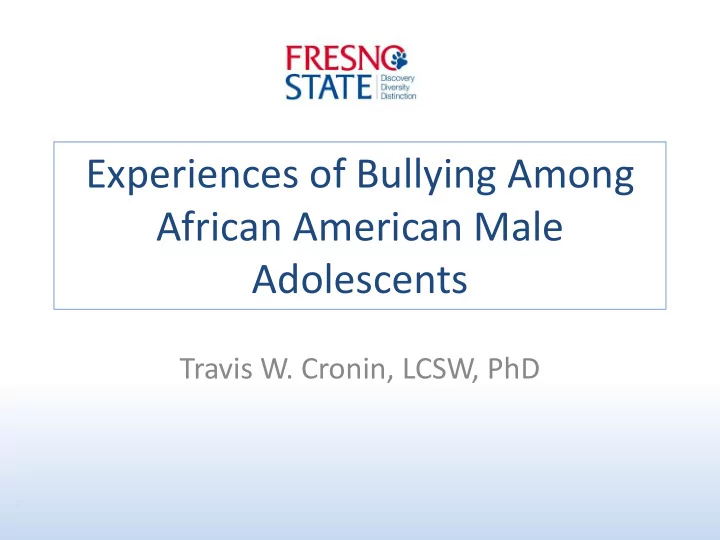

Experiences of Bullying Among African American Male Adolescents Travis W. Cronin, LCSW, PhD
African American Male Adolescents • Lowest Reports of Bully Victimization at School (CDC, 2016) • Highest Reports of Getting into a Fight at School (CDC, 2016) • Unique experiences in primarily White institutions (Daniel Tatum, 1997)
Methods • Phenomenological Interviews (Padgett, 2008) • Sample & Data Collection ( N = 16) • Analysis of findings (Moustakas, 1994)
Sample • 13-19 years old • Straight • Middle Class • On track to graduate from high school-with highly educated parents
What does bullying mean to you? • Emotion/Power • Entertainment • Fighting • Structure • Home
Emotional Influence as Power “It’s usually meant to upset someone. You can repeatedly call someone a name to make them feel sad or unhappy. Like, you do it, you keep doing it, and they don’t want you to do it.” Bill (14)
Emotional Influence as Power “They are [bullying] because they know he’s not going to do nothing. It puts that person at a different mind state to where they could kill themselves.” Gibby (18)
Entertainment (Roasting) “It’s just that we don’t take it as serious. People would think it was fun to roast each other. For example, sometimes people be like ‘Dang you ugly!’ and they just go back and forth like it’s a game. They’ll have people crowded around just talking about each other, just laughing and stuff. ” Darvis (17)
Entertainment (Jokes) “[I have been told] my hairline is fronted by Skittles because it’s a rainbow… He said that multiple times, and he got a bunch of laughs about that. Most of the time it’s meant to be funny, but sometimes people can take it out of hand. . . . [I]t gets to a point where one side just stops completely, because you’ve gone too far.” Jumpman (13)
Fighting “ I know that with fights . . . people try to fuel the fights . . . [T]his is kind of like bullying too because, people look at it like, if you don ’ t fight, ‘Oh, you ’ re a wimp! You don ’ t want to fight.’ So that ’ s peer pressure and that peer pressure actually causes them to fight. ” K-Dizz (15)
Fighting “Verbally attacking someone, physically punching, fighting, calling somebody names, or cussing at someone.” Z (13)
Structure “They don’t have trust in law enforcement, because the people who are supposed to have their backs are the ones killing them.” Gibby (18)
Structure “I would say [my son’s experience] has been absolute hell educationally. And it started with a teacher that he had when he was 4 years old.” Dumbledore (Mother)
Home “I think it starts at home. That’s a key part. maybe you don’t get the attention you want at home. You want to get attention, so you bully people.” Cinco (18)
Home “Different home environments…an abusive home environment, or a nice home environment.” Jax (19)
Implications • Community Informed Assessment (e.g. jokes, fighting) • Targeted community based bullying prevention programs that enhance existing community strengths
Limitations • Design (i.e., sample, member checking) • Reflexivity (i.e., insider, outsider)
References (1 of 2) Alexander, M. (2012). The new Jim Crow: Mass incarceration in the age of colorblindness . New York: The New Press. Bell, D. A. (1980). Brown v board of education and the interest-convergence dilemma. Harvard Law Review, 93 (3), 518 – 533. Centers for Disease Control and Prevention. (2016). Youth Risk Behavior Survey Data. Available at: www.cdc.gov/yrbs. Accessed on June 15, 2016. Collins, P. H. (2000). The social construction of Black feminist thought. In James, J. & Sharpley- Whiting, T. D. (Eds.), The Black feminist reader (pp. 183 – 207). Massachusetts: Blackwell. Creswell, J. W., Hanson, W. E., Clark Plano, V. L., & Morales, A. (2007). Qualitative research designs: Selection and implementation. The Counseling Psychologist , 35, 236-264. Doi: 10.1177/00100000628739 Hinduja, S., Patchin, J. W. (2012). Cyberbullying: Neither an epidemic nor a rarity. European Journal of Developmental Psychology , 9(5), 539-543. doi: http//dx.doi.org/10.1080/ 17405629.2012.706448 Jordan, K., & Austin, J. (2012). A review of the literature on bullying in U.S. schools and how a parent–educator partnership can be an effective way to handle bullying. Journal of Aggression, Maltreatment & Trauma, 21 (4), 440-458. doi: http://dx.doi.org/10.1080/10926771.2012.675420
References (2 of 2) Katz, J. (2006). The macho paradox: Why some men hurt women and how all men can help. Naperville, IL: Sourcebooks, Inc. Moustakas, C. (1994). Phenomenological research methods . Thousand Oaks, CA: Sage Publications. Olweus, D. (2013). School bullying: Development and some important changes. Annual Review of Clinical Psychology , 9, 751-780. Padgett, D. (2008). Qualitative methods in social work research . New York University, New York: Sage Publications, Inc. Staub, E. (2003). The psychology of good and evil: Why children, adults and groups help and harm others . New York: Cambridge University Press. Tatum, B. D. (1997/2003). Why are all the Black kids sitting together in the cafeteria? And other conversations about race . New York: Basic Books.
Recommend
More recommend